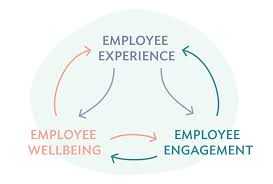FEB 2023, Vol 20, Issue 2
Overview
- 5 Ways Leaders Can Amplify Employee Wellbeing with Recognition
- AAP Time
- Delaware Anti-Sexual Harassment Law Training Requirements
5 Ways Leaders Can Amplify Employee Wellbeing with Recognition
by Workhuman
Regardless of where employees work – in the office, from home, on the manufacturing line, or anywhere else – today’s employers have an imperative to take care of their people. It’s better for the people who work there, and it’s better for business. Which is why employee wellbeing comes hand in hand with psychological safety.
Employee wellbeing is a valuable tool for establishing meaningful connections at work, as well as for improving business metrics including retention, engagement, and productivity. The research also shows it is underutilized.
For organizations to thrive in today’s fast-paced business landscape, their employees need to thrive too. And an effective way to help them thrive is with employee recognition. When employees feel appreciated, they are much more likely to thrive. Here we will share five ways leaders can promote and amplify employee wellbeing in the workplace with recognition, plus tips and tricks to make sure they stick.
One - Make smarter investments in wellbeing. The past few years have put pressure on employers to provide more benefits to keep their employees physically and mentally well. And many organizations likely provided some resources to those asking for them.
Leaders should ask themselves: How are those resources and initiatives performing now? Are they still effective? Were they ever? If they aren’t sure, it’s time to reassess.
Leaders should start by examining how they allocate resources to these initiatives, and if they aren’t paying off, sunset the program and direct those funds elsewhere. One area to consider investing further in is recognition. Investing in recognition will likely make organizational dollars go farther than the one-off projects they were funding before – and it comes with a compelling ROI for wellbeing and more.
Two - Be strategic about recognition. When approaching employee wellbeing, business leaders should be strategic about the tools they use.
Peer-to-peer recognition has the power to amplify wellbeing at work because it gives everyone the ability to give and receive appreciation. Using recognition has the power to reduce turnover, improve employee morale, and increase productivity. But those gains happen only when it is implemented and used correctly. And doing recognition correctly means it has to be more than a yearly pizza party or an engraved pen.
According to a previous Workhuman-Gallup report, “Unleashing the Human Element at Work: Transforming Workplaces Through Recognition,” organizations get the most out of their recognition investment when they follow the five pillars of recognition.
** * Five Pillars of Recognition:***
- Fulfilling: The moments of appreciation should be genuine and create a consistent, reliable experience for both the giver and receiver.
- Authentic: Recognition moments should mean something to both the giver and receiver.
- Equitable: Every award message should be unique to the people giving and receiving, but the rate at which they receive and the amount in which they receive should be equitable.
- Personalized: Recognition givers should consider how the person they are recognizing prefers to be recognized for their work, whether that be publicly, privately, or a bit of both.
- Embedded in organizational culture: Appreciation should be woven into employees’ everyday work lives to build a genuine culture of recognition.
Three - Integrate recognition and wellbeing practices. Thriving employees are crucial to the success of businesses. The better they feel, the more engaged and productive they will be – not to mention they will be producing higher quality work.
The Gallup wellbeing report found employees who strongly agree that recognition is an important part of their culture are up to 91% more likely to be thriving in their lives. They are also up to 84% more likely to be thriving when they agree they get the right amount of recognition for the work they do.
Additionally, employees who report receiving recognition from managers and leaders at least a few times a month are up to 2x as likely to be thriving as their counterparts.
Knowing this, leaders should intentionally and explicitly design initiatives to bring recognition and wellbeing together.
** * How to bring recognition & wellbeing together***
- Integrate wellbeing into the company’s core values.
- Create an award for employees who promote wellbeing.
- Acknowledge employees’ wellbeing- related achievements such as marathons or yoga certifications.
- Use company wide recognition events as an excuse to boost social wellbeing by being together.
Four - Upskill managers. A manager can make or break an employee’s success at a company. To ensure employees are getting the coaching, support, and value they need to grow, employers should be actively engaging managers in learning and development courses. And wellbeing is no exception.
Organizations should train managers on the importance of wellbeing in the workplace, as well as the impact employee recognition has on sustaining that wellbeing. Only when employees at all levels of the company realize the impact being valued has on wellbeing will they be able to integrate it into their work routines.
Through their words and actions, managers and leaders shape the work culture environment. That environment impacts employees’ overall lives and wellbeing every day. With so much influence on the employee experience, it becomes even more important to provide managers with specific actions, goals, and tools to bring recognition to life for those they lead.
Five - Lead by example. Organizations need to be committed to building employee recognition into their culture to sustain wellbeing, and that starts at the top. Leaders should set the tone for how the entirety of the organization should be spreading appreciation and encouraging others to do the same.
If organizations are arranging volunteer activities for employees, leaders should be participating as well. They should encourage employees to make use of mental health resources offered by the company and set up time to discuss and improve those offerings based on employee feedback.
Leaders should also give shoutouts for shared milestones, attend team award programs and informal celebrations, post to recognition platforms, and reply to email chains. Every action counts. In time, a culture of recognition will take hold.
Employee wellbeing is no longer optional. Organizations wishing to attract and retain top talent must be actively working toward building a workplace that supports the well being of their people. And with the help of employee recognition, bringing a culture of wellbeing to the workplace is possible – and it’s worth it.
- - - -
AAP Time
Many Affirmative Action Plans (AAPs) expired on December 31, 2022. Under federal law they must be updated annually and should be submitted to DOL during the first quarter of 2023.
- - - -
Delaware Anti-Sexual Harassment Law Training Requirements
The Delaware law that specifically addresses prohibition against sexual harassment under the Delaware Discrimination in Employment Act (DDEA), requires anti-sexual harassment training requirements for employers, with 50 or more employees in the state, every two years. Contact HR Strategies to schedule your organization’s required training.
- - - -
Contact HR Strategies at 302.376.8595 or info@hrstrategies.orgif you would like support or would like to learn more about the items in this newsletter. Please contact us if you would like to be added to our Monthly Strategies mailing list or if you would like for us to add someone to our mailing list.


